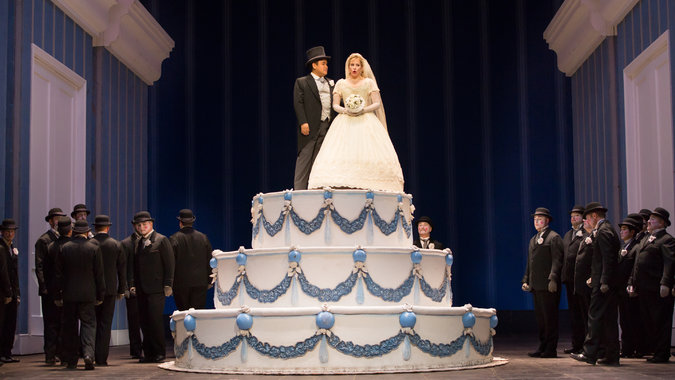The Maestro’s Corner: Rossini’s La Cenerentola
May 4, 2015
Everyone knows the story of Cinderella — it would be up there alongside Hansel and Gretel and The Ugly Duckling in a list of favorite children’s stories. There are hundreds of different versions of the tale spread across storytelling history. It’s also been visually celebrated in not only one but two Disney movies.
Disney wasn’t the only one to set this classic fairy tale to music; The Italian composer Gioachino Rossini (1792 –1868) wrote the operatic version, La Cenerentola, in 1817. Rossini was 25 when he wrote the opera, and he wrote the entire thing in only three weeks. It was first performed in Rome at the Teatro Valle on January 25, 1817.
La Cenerentola is one of Rossini’s funniest operas—and that’s saying something, as Rossini specialized in comedy. (Another of his great comedic works is the immortal Il barbiere di Siviglia – “The Barber of Seville”). La Cenerentola is full of subtle digs at pompous pretenses and the etiquette-stiffened attitude of early 19th-century society. It is both a charming fairy tale and a glittering plate of clever social commentary.
However, in its essence, La Cenerentola is pure entertainment. Rossini stayed true to the original fairy tale in most respects, but he did make a few conspicuous changes. For one thing, the names are all different. For another, there is no fairy godmother, nor are there talking mice or a carriage made of an bewitched pumpkin. In fact, Rossini scrubbed nearly all of the magic spells out of the fairy tale. He probably did this to make it more credible. Operas are often based around true stories or “what if” inspirations, and Rossini wanted La Cenerentola to be an almost-believable story of the royal court. He replaced the fairy godmother with the wise man Alidoro, court philosopher and the teacher of the Prince. However, Alidoro has such a mysterious aura that one wonders if he is indeed a wizard! Another of the most obvious changes is the switch from a lost glass slipper to a set of matching bracelets. Rossini had to make this change, simply because, in 19th-century Italy, it was considered improper for a lady to show her ankles in public.
The basic plot of La Cenerentola is that Alidoro—disguised as a beggar—comes to the house of the pompous Don Magnifico in order to scout out a potential bride for the Prince. He immediately sizes up the family situation: while Clorinda and Tisbe (the ugly stepsisters) squander the family fortune on expensive fashions, and Don Magnifico lazes around the house, poor Angela (Cinderella) tries vainly to do all the chores and avoid her crabby stepfather. However, when Alidoro appears at the door, Cinderella does her best to help him. Struck by her kindness and beauty, Alidoro hurries off to tell Don Ramiro (the handsome Prince) that the bride has been found. The Prince, disguised as a servant, comes to Don Magnifico’s house to meet her, and the two fall in love at first sight. The Prince has also come to bring word of the great ball at the palace; Clorinda and Tisbe are all aflutter and run to tell their father. Then, a royally-dressed “Prince” shows up to take them to the ball! What the two stepsisters don’t realize is that this fellow is not actually the Prince. The Prince and his manservant, Dandini, have switched clothes. While the girls are flirting with the phony prince, the real Prince will be searching for his bride. Cinderella begs to go to the ball, but her stepfather casts her off. Alidoro tries to tell everyone that Cinderella is not actually a servant girl, but when he asks to see Don Magnifico’s third daughter, the old Don lies and says that she died. So, everyone goes off to the ball, leaving Cinderella weeping at home. Luckily, Alidoro comes back with his private carriage, and she is soon dressed up and arriving at the palace. The rest of the story is pretty simple; she meets the Prince (still disguised as a servant) and they fall even deeper in love. However, she has to get home before her stepfamily, so they don’t find out where she’s been. Before she flees, she gives the Prince a bracelet and tells him that she has another just like it. When he finds the girl with the matching bracelet, he will have found her. The Prince finds Cinderella, the truth about the change of clothes comes out, and the opera ends triumphantly with the wedding of the Prince and Cinderella.
La Cenerentola sparkles with beautiful music and witty banter. So the next time you want a little musical magic, give this opera a spin. A classic fable goes through a glamorous transformation under the skill of the masterful Rossini. You’ll never look at a book of fairy tales– or the animated Disney film–the same way again.



